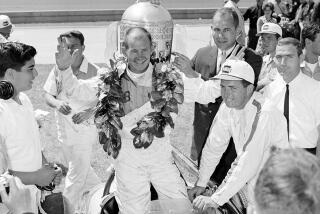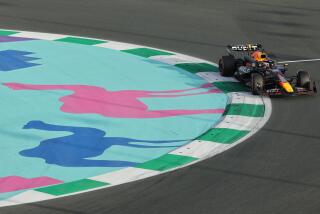Seizing the wheel of a Formula One race car for 7 thrilling minutes
Reporting from THERMAL, Calif. — I wasn’t scared until they lashed me into the cockpit. Then I was terrified.
I had come to the private Thermal Racing Club near Palm Springs for the rare opportunity to drive a Formula One race car under the instruction of driving professionals.
------------
FOR THE RECORD
Formula One: A March 21 Business section story about a Formula One driving course referred to Simona de Silvestro as a driver for Mario Andretti. De Silvestro drives for Andretti Autosports, which is run by Michael Andretti.
------------
As one of a dozen drivers who signed up for the Formula One GP Experience, I was strapped into a 1,100-pound, 620-horsepower Renault race car, getting prepped for the fastest seven minutes of my life.
The one-day event was based on a series that began in Europe a decade ago. Formula One GP Experience drivers pay as much as $9,995 for a few high-speed laps around the track and the day of training to prepare.
This isn’t the only place where gearheads can get a high-octane racetrack fix. Numerous venues around the country offer a variety of exclusive driving experiences. They can get racing lessons at Willow Springs in the Antelope Valley and drive exotic supercars in Las Vegas.
But the GP Experience at Thermal is the track in the U.S. where they can pilot an authentic Formula One car.
With me were other aficionados. All were male. One brought his wife. Another brought his wife and two teenage kids. Two thirtysomething entrepreneurs were carrying their own driving suits and helmets.
“We give people the opportunity to step into the world of F1 and experience it — not by watching, but by driving,” said program co-founder Jean Paul Libert.
The day started early. At 7 a.m., the other drivers and I had been introduced to Didier Theys, a 58-year-old Belgian-born veteran of the 24 Hours of Daytona and 24 Hours of Le Mans endurance races, and 26-year-old Simona de Silvestro, who drives for racing legend Mario Andretti and already has several years of IndyCar series experience.
An hour of classroom instruction was followed by a run around the 1.8-mile-long track — but not in a Formula One car, yet. From behind the wheel of a street-legal Lotus Evora coupe, with one driving coach in the passenger seat and another leading me around the course in a track-only Lotus Exige, I was shown the best lines through the turns and the best ways to avoid destroying the million-dollar Renault F-1 that I would drive later.
After a break for lunch, we got more classroom instruction.
“Use the throttle like the knob of the stereo, not like a switch,” Theys warned. “If you use it like a switch, you’re going to spin off. And if you spin off, the guardrail is not very far; we have to stop the program.”
I would also have to pay the program’s $7,500 insurance deductible.
Next, the other drivers and I were fitted for our fireproof racing suits, driving gloves, shoes and helmet.
Meanwhile, technicians were warming up the F1’s engine and tires. The steady high-pitched revs of the car’s V-10 engine echoed off the track buildings, mixing with the wind that was whipping dust and sand into the air.
Dave Vandenberg, a 67-year-old technology consultant from Turlock, Calif., was first up. The instructors had deemed him fastest around the track — a credit to his decades of driving and racing Alfa Romeos and Chevy Camaros.
For a lap, he tailed De Silvestro in the Lotus before screaming past the pits three times on his solo laps. The veteran privateer coasted back into the pits and crawled from the car, beaming.
“That was an unbelievable experience,” he said.
Catching his breath, he admitted he’d been nervous, driving fast but with caution.
“I didn’t want to stuff it into a corner,” he said. “I don’t want to lose my house.”
Other drivers followed Vandenberg, each returning breathless and grinning.
Then the technicians shoved me into the car, tightening the straps on my helmet and seat harness until I could hardly breathe. Then they bolted in the removable steering wheel.
Over the roar of the idling engine, a driving coach squatted at my ear and implored me to be careful with the super-light, super-powerful Renault. An earlier driver had spun out on a tricky corner.
“You must bring it back whole,” he said.
De Silvestro pulled out in the Lotus. I followed, making a sharp left turn out of the pits.
I took the first few turns gingerly, getting used to the tight steering and the super-sensitive throttle, and then began accelerating through the gears up the track’s first straight section.
Even though I was taking it easy, every shift cracked the back of my helmet against the hard seat-back as the Renault lunged forward.
At the end of the straight, mindful of Theys’ instruction, I waited as long as possible to apply the brakes. Finally, when it felt I was far past the point of no return, I stepped hard on the pedal and exited the turn unscathed.
A few turns later I hit the track’s long straightaway.
My heart in my throat, and my breathing tight, I was so focused on the pavement in front of me that I never even looked down to check my speed. One hundred mph? One hundred fifty mph? I have no idea.
After another lap, I was beginning to get the F1’s feel. I waited out another corner, delaying for what seemed forever to jam on the brakes and turn the wheel. The car sliced through the apex and stuck to the road like it wasn’t even trying.
Then it was over. The course marshal signaled me in. As instructed, I killed the engine as the car coasted into the arms of its handlers.
Then I climbed out slowly. Libert asked what I thought. But my head was spinning, and I found I could manage only one-word answers.
The day ended with each of us getting a set of hot laps in a custom-built, three-seat F1 vehicle. The drivers and their spouses sat in separate cockpits, on either side of Theys, for one final sense of what a pro racer does on an F1 track.
The sun was falling below the mountains, leaving the track in shade. We were all given a heavy square glass paperweight as a memento.
The exclusivity of the event is part of the draw for well-heeled customers, Libert observed.
“It’s very unique and aspirational,” he said. “You become part of a very selective club.”







